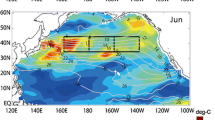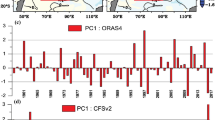Abstract
The skewness of subsurface temperature anomaly in the equatorial Pacific Ocean shows a significant asymmetry between the east and west. A positive temperature skewness appears in the equatorial eastern Pacific, while the temperature skewness in the western and central Pacific is primarily negative. There is also an asymmetry of the temperature skewness above and below the climatological mean thermocline in the central and western Pacific. A positive skewness appears below the thermocline, but the skewness is negative above the thermocline. The distinctive vertical asymmetry of the temperature skewness is argued to be attributed to the asymmetric temperature response to upward and downward thermocline displacement in the presence of the observed upper-ocean vertical thermal structure. Because of positive (negative) second derivative of temperature with respect to depth below (above) the thermocline, an upward and a downward shift of the thermocline with equal displacement would lead to a negative temperature skewness above the thermocline but a positive skewness below the thermocline. In the far eastern equatorial Pacific, the thermocline is close to the base of the mixed layer, the shape of the upper-ocean vertical temperature profile cannot be kept. Positive skewness appears in both below the thermocline and above the thermocline in the far eastern basin. Over the central and eastern Pacific, the anomalies of the subsurface waters tend to entrain into the surface mixed layer (by climatological mean upwelling) and then affect the SST. Hence, the positive (negative) subsurface skewness in the far eastern (central) Pacific may favor positive (negative) SST skewness, which is consistent with the observational fact that more La Niña (El Niño) occur in the central (eastern) Pacific. The present result implies a possible new paradigm for El Niño and La Niña amplitude asymmetry in the eastern Pacific.
Similar content being viewed by others
References
An S I, Jin F F. 2004. Nonlinearity and Asymmetry of ENSO. J. Climate, 17: 2 399–2 412.
Battisti D S, Hirst A C. 1989. Interannual variability in a tropical atmosphere-ocean model: Influence of the basic state, ocean geometry and nonlinearity. J. Atmos. Sci., 46: 1 687–1 712.
Burgers G, Stephenson D B. 1999. The “Normality” of El Niño. Geophys. Res. Lett., 26: 1 027–1 030.
Cane M A, Zebiak S E. 1985. A theory of El Niño and the Southern Oscillation. Science, 228: 1 084–1 087.
Carton J, Chepurin G, Cao X, Giese B. 2000. A simple ocean data assimilation analysis of the global upper ocean 1950–95. Part I: Methodology. J. Phys. Oceanogr., 30: 294–309.
Chao J P, Yuan S Y, Chao Q C, Tian J W. 2003. The origin of warm water mass in “Warm Pool” subsurface of the Western Tropical Pacific-the analysis of the 1997∼1998 El Niño. Chinese Journal of Atmospheric Sciences, 27(12): 145–151. (in Chinese with English abstract)
Gu D J, Wang D X, Li C H, Wu L X. 2004. Analysis of interdecadal variation of tropical Pacific thermocline based on assimilated data. Acta Oceanologica Sinica, 23(1): 61–67.
Hong C C, Li T, Lin Ho, Kug J S. 2008. Asymmetry of the Indian Ocean dipole. Part I: Observational analysis. J. Climate, 21: 4 834–4 848.
Jin F F. 1997. An equatorial ocean recharge paradigm for ENSO. Part I: Conceptual model. J. Atmos. Sci., 54: 811–829.
Li H Y, Xie Q, Wang D X. 2006. Interannual variations of sub2surface salinity in the tropical Pacific Ocean. Acta Ocean. Sinica, 28(6): 5–11. (in Chinese with English abstract)
Li C Y, Mu M Q. 1999. El Niño occurrence and subsurface ocean temperature anomalies in the Pacific Warm Pool. Chinese Journal of Atmospheric Sciences, 23(5): 513–521. (in Chinese with English abstract)
Li T. 1997. Phase transition of the El Niño-Southern Oscillation: A stationary SST mode. J. Atmos. Sci., 54: 2 872–2 887.
Lin Y H, You X B, Guan Y P. 2004. Interannual variability of mixed layer depth and heat storage of upper layer in the tropical Pacific Ocean. Acta Ocean. Sinica, 23(1): 31–39.
McPhaden M J, co-authors. 1998. The Tropical Ocean-Global Atmosphere observing system: a decade of progress. J. Geophys. Res., 103: 14 169–14 240.
McPhaden M J. 1999. Genesis and evolution of the 1997–98 El Niño. Science, 283: 950–954.
McPhaden M J, Yu X. 1999. Equatorial Waves and the 1997–98 El Niño. Geophys. Res. Lett., 26(19): 2 961–2 964.
Philander S G H. 1990. El Niño, La Niña, and the Southern Oscillation, Academic Press, 293 pp.
Picaut J, Masia F, du Penhoat Y. 1997. An advective-reflective conceptual model for the oscillatory nature of the ENSO. Science, 277: 663–666.
Rasmusson E M, Carpenter T H. 1982. Variations in tropical sea surface temperature and surface wind fields associated with the Southern Oscillation/El Niño. Mon. Wea. Rev., 110: 354–384.
Su J Z, Zhang R, Li T et al. 2009. Causes of the El Niño and La Niña amplitude asymmetry in the equatorial eastern Pacific. J. Climate (In press)
Suarez M J, Schopf P S. 1988. A delayed action oscillator for ENSO. J. Atmos. Sci., 45: 3 283–3 287.
Sun J L, Chu P, Liu Q Y. 2004. The seasonal variation of undercurrent and temperature in the equatorial Pacific jointly derived from buoy measurement and assimilation analysis. Acta Ocean. Sinica, 23(1): 51–60.
Weisberg R H, Wang C. 1997. Slow variability in the equatorial west-central Pacific in relation to ENSO. J. Climate, 10: 1 998–2 017.
White H G. 1980. Skewness, kurtosis and extreme values of Northern Hemisphere geopotential heights. Mon. Wea. Rev., 108: 1 446–1 445.
Zhang R, Chao J. 1993a. Unstable tropical air-sea interaction waves and their physical mechanisms. Adv. Atmos. Sci., 10: 61–70.
Zhang R, Chao J. 1993b. Mechanisms of Interannual Variations in a Simple Air-Sea Coupled Model in the Tropics. In: Ye D I et al., ed. Climate Variability China Meteorological Press, Beijing, China. p. 236–244.
Author information
Authors and Affiliations
Corresponding author
Additional information
Supported by the National Basic Research Program of China (973 Program)(No. 2007CB816005), the National Natural Science Foundation of China (No. 40706003), International S&T Cooperation Project of the Ministry of Science and Technology of China (No.2009DFA21430), and the COPES in China (GYHY200706005)
Rights and permissions
About this article
Cite this article
Su, J., Zhang, R., Li, T. et al. Skewness of subsurface ocean temperature in the equatorial Pacific based on assimilated data. Chin. J. Ocean. Limnol. 27, 600–606 (2009). https://doi.org/10.1007/s00343-009-9150-y
Received:
Accepted:
Published:
Issue Date:
DOI: https://doi.org/10.1007/s00343-009-9150-y




